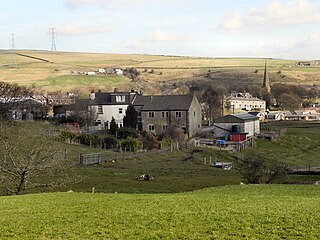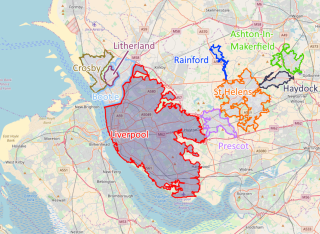Related Research Articles

West Midlands is a ceremonial county in the larger West Midlands region of England. A landlocked county, it is bordered by Staffordshire to the north and west, Worcestershire to the southwest, and is surrounded by Warwickshire to the east and southeast. The largest settlement is the city of Birmingham.

A metropolitan area or metro is a region consisting of a densely populated urban agglomeration and its surrounding territories sharing industries, commercial areas, transport network, infrastructures and housing. A metropolitan area usually comprises multiple principal cities, jurisdictions and municipalities: neighborhoods, townships, boroughs, cities, towns, exurbs, suburbs, counties, districts and even states and nations in areas like the eurodistricts. As social, economic and political institutions have changed, metropolitan areas have become key economic and political regions.

Metropolitan counties are a subdivision of England which were originally used for local government. There are six metropolitan counties: Greater Manchester, Merseyside, South Yorkshire, Tyne and Wear, West Midlands and West Yorkshire.

A conurbation is a region comprising a number of metropolises, cities, large towns, and other urban areas which through population growth and physical expansion, have merged to form one continuous urban or industrially developed area. In most cases, a conurbation is a polycentric urbanised area in which transportation has developed to link areas. They create a single urban labour market or travel to work area.

The West Midlands conurbation is the large conurbation in the West Midlands region of England. The area consists of two cities and numerous towns: to the east, the city of Birmingham, along with adjacent towns of Solihull and Sutton Coldfield; and to the west, an area called the Black Country, which includes the city of Wolverhampton as well as the nearby towns of Dudley, Walsall, Sandwell, Stourbridge and Halesowen.

The London metropolitan area is the metropolitan area of London, England. It has several definitions, including the London Travel to Work Area, and usually consists of the London urban area, settlements that share London's infrastructure, and places from which it is practicable to commute to work in London. It is also known as the London commuter belt, or Southeast metropolitan area.
The West Midlands region straddles the historic borders between the counties of Warwickshire, Staffordshire in the north, and Worcestershire in the south.

Greater Glasgow is an urban settlement in Scotland consisting of all localities which are physically attached to the city of Glasgow, forming with it a single contiguous urban area. It does not relate to municipal government boundaries, and its territorial extent is defined by the General Register Office for Scotland, which determines settlements in Scotland for census and statistical purposes. Greater Glasgow had a population of 1,199,629 at the time of the 2001 UK Census making it the largest urban area in Scotland and the fifth-largest in the United Kingdom. However, the population estimate for the Greater Glasgow 'settlement' in mid-2016 was 985,290—the reduced figure explained by the removal of the Motherwell & Wishaw (124,790), Coatbridge & Airdrie (91,020), and Hamilton (83,730) settlement areas east of the city due to small gaps between the populated postcodes. The 'new towns' of Cumbernauld and East Kilbride (75,120) were never included in these figures despite their close ties to Glasgow due to having a clear geographical separation from the city. In the 2020 figures, the Greater Glasgow population had risen to just over 1 million.

The city of Birmingham, in England, is an important manufacturing and engineering centre, employing over 100,000 people in the industry and contributing billions of pounds to the national economy. During 2013, the West Midlands region as a whole created UK exports in goods worth £19.6 billion, around 8.73% of the national total, however, exports fell by 14.5% compared to 2012 and there is a trade deficit of £5.6 billion. Output was forecast to grow from 2007 to 2012, but the city's economy flat-lined in from 2007 to 2009, following the economic crisis which affected the economies of countries around the world.

A city proper is the geographical area contained within city limits. The term proper is not exclusive to cities; it can describe the geographical area within the boundaries of any given locality. The United Nations defines the term as "the single political jurisdiction which contains the historical city centre."

Wardle is a village near Littleborough within the Metropolitan Borough of Rochdale, in Greater Manchester, England. It lies amongst the foothills of the South Pennines, 1.8 miles (2.9 km) east-southeast of Whitworth, 2.5 miles (4 km) north-northwest of Rochdale and 12 miles (19 km) north-northeast of the city of Manchester.

The Greater Manchester Built-up Area is an area of land defined by the Office for National Statistics (ONS), consisting of the large conurbation that encompasses the urban element of the city of Manchester and the metropolitan area that forms much of Greater Manchester in North West England. According to the United Kingdom Census 2011, the Greater Manchester Built-up Area has a population of 2,553,379 making it the second most populous conurbation in the United Kingdom after the Greater London Built-up Area. This was an increase of 14% from the population recorded at the United Kingdom Census 2001 of 2,240,230, when it was known as the Greater Manchester Urban Area.
Greater Bristol is a term used for the conurbation which contains and surrounds the city of Bristol in the South West of England. There is no official "Greater Bristol" authority, but the term is sometimes used by local, regional and national authorities, and others as a synonym for either the "Bristol Urban Area" or a wider area of the former County of Avon, and by some, TfGB, to refer to the Province of Bristol as defined by C. B. Fawcett (1919) or Derek Senior (1969).

The Liverpool Built-up Area is a term used by the Office for National Statistics (ONS) to denote the urban area around Liverpool in England, to the east of the River Mersey. The contiguous built-up area extends beyond the area administered by Liverpool City Council into adjoining local authority areas, particularly parts of Sefton and Knowsley. As defined by ONS, the area extends as far east as St Helens, Haydock, and Ashton-in-Makerfield in Greater Manchester.

The second city of the United Kingdom is usually recognised as Birmingham. The title is not an official one and its reckoning is subjective and cultural: the UK has a primate city structure where London significantly surpasses other cities in size and importance and all other cities have much more in common with one another than with the capital.

A travel to work area or TTWA is a statistical tool used by UK Government agencies and local authorities, especially by the Department for Work and Pensions and Jobcentres, to indicate an area where the population would generally commute to a larger town, city or conurbation for the purposes of employment.

A metropolitan area is generally defined as consisting of an urban area, conurbation or agglomeration, together with the surrounding area to which it is closely economically and socially integrated through commuting.
References
- ↑ "The changing geography of the UK economy". Centre for Cities. 7 December 2015. Retrieved 12 December 2021.
- 1 2 3 Frequently asked questions about the state of the English cities Archived 2007-11-02 at the Wayback Machine Department for Communities and Local Government (see "What is a Primary Urban Area (PUA)?")
- ↑ "Primary Urban Areas (PUAS)] State of the Cities - Making sense of cities". Department for Communities and Local Government. Archived from the original on 2007-07-06. Retrieved 2007-09-06.
- ↑ Key Statistics for Urban Areas in England and Wales Archived 2004-07-22 at the UK Government Web Archive Office for National Statistics Census 2001 (definition on page 8 of pdf)
- ↑ Robinson, Phillipa. "Presenting Statistics on UK Geographies". State of the Cities Database. North East Regional Information Partnership. Archived from the original on 2007-09-30.
- 1 2 Department of Communities and Local Government English City-Regions based on labour and housing markets
- ↑ "Urban Audit Analysis II" (PDF). Eurostat. Archived from the original (PDF) on 2008-10-30. Retrieved 2008-10-05.
- ↑ "European Regional and Urban Statistics" (PDF). Eurostat. Archived from the original (PDF) on 2008-10-30. Retrieved 2008-10-05.
- ↑ "Urban Audit - City Profiles: Wolverhampton". Urban Audit. Archived from the original on 2011-05-23. Retrieved 2008-10-05.
- ↑ "The changing geography of the UK economy". The Centre for Cities. 17 December 2015. Retrieved 26 September 2023. (Overview)
- ↑ "The changing geography of the UK economy: a review of the Primary Urban Area definition" (PDF). The Centre for Cities. 17 December 2015. Retrieved 26 September 2023. (Detail)
- ↑ "Defining cities" (PDF). The Centre for Cities. 17 December 2015. Retrieved 26 September 2023. (Includes for each PUA a list of the local authorities it comprises.)